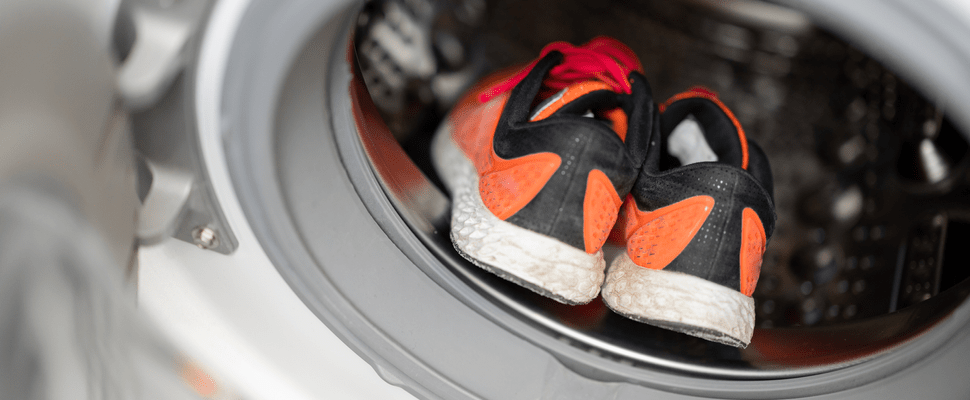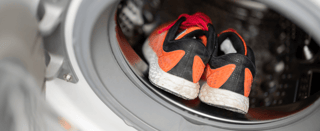Can you put shoes in the washer and dryer?
How to wash sneakers: Let us count the ways

Key tips to remember
- Yes, you can wash many athletic trainers and sneakers in the washing machine
- Never put leather, rubber, suede or vinyl shoes in the washing machine
- Never put any kind of shoe in a dryer; air-dry them instead
- Make sure to remove laces and insoles before washing
- Use gentle cycle settings and cold water
So, your sneakers are dirty, and you’re thinking it’s time to try something new to get them clean. But tossing them into that next load of laundry without a second thought gives you pause. We’re glad you paused because there are some factors to think over first. Fear not, dear reader; we are here to help! If you’re wondering how to wash shoes in the washing machine, you’re reading the right article. Let’s say you’ve recently made your way through our DIY guide to home laundry and still have a few questions, namely: Can you put sneakers in the washing machine? The short answer is yes, but there is more to consider. The long answer is outlined at length in this post, so read on for all you need to know before you decide to put your shoes into the washing machine.
Washing shoes in washer
Your first consideration when looking at how to wash sneakers in the washer is what your shoe manufacturer has to say about it. Some of the big brands recommend against it without exception, so it’s a good idea to look at the shoes’ tongue or tag for clues. You can also look at the brand’s website for any information you can find about machine-washing athletic shoes. If the brand says it’s a bad idea, you might prefer to explore hand-washing techniques for your favorite sneakers, and we’ll cover some of those. However, you can still use the washing machine even if the brand says no, but you must accept that you might damage the shoes and will almost certainly void any warranty coverage you might have. Warranty coverage for sneakers? Yep, it’s a thing.
Shoe types
Sneakers are usually made from synthetics like nylon, canvas, cotton and polyester. These fabrics are durable and better at handling the washing machine (and laundry detergent) experience. Just make sure you don’t use powder detergents, which can fail to dissolve completely, and remove the laces and insoles first. Insoles are best cleaned by hand, and laces can go in the machine, albeit inside a wash bag or pillowcase. Other shoe types, like those made of rubber, leather, suede or vinyl, should only be washed by hand because they damage easily. Specialty shoes that are particularly delicate, like those made of silk or featuring decorative attachments, should also be cleaned carefully by hand or taken to a shoe repair and cleaning professional.
Stuff you might need
If you’re thinking about washing your shoes in the machine, you’ll want to put together a few accessories to accomplish this carefully (and hopefully without any damage to the shoes or the machine). These helpful items include a pillowcase, mesh garment bag or wash bag to contain the shoes in the wash; a few old towels or jeans to throw in with the shoes for help balancing the load; a toothbrush or other soft type of brush; liquid detergent (not dish soap); baking soda; and some type of cream-based sneaker cleaner, sort of like shoe polish, which you can find at a discount store, shoe store or many online retailers.
Machine types and settings
Gentle settings make for an easier trip through the machine, and cold water has less of an impact on your shoes, making it less likely that colors run or shapes distort. Keep the spin slow and the setting delicate. Impeller models are perhaps the gentlest types of washing-machines. Though they’re top-loaders, they lack the column — sometimes called the agitator — that can damage clothes. Unfortunately, impeller models are rare. Most top-loaders are agitators, but you can still wash your sneakers this way; just be sure to use a cold-water setting and a delicate cycle with the sneakers in the bag. The best situation is if you have a front-loader because this type of machine is generally not as hard on the clothes (or the shoes). They also tend to offer more precise control over functions like rate of spin and temperature settings, making a cold-water, slow-spinning setting easier to accomplish for optimal sneaker-washing conditions.
Tips for wash time
Aside from what we wrote above, the process of washing your shoes in the machine is self-explanatory, but you may want to take a moment to knock off any dirt or rocks stuck to your shoes, even before you bring them back into the house. Adding chunks of mud or little pebbles (or both) into the laundry isn’t going to do you (or your washing machine) any favors.
Dryer time?
Can you put shoes in the dryer? The short answer is no, but there’s good reasoning behind it. Dryer temperatures are simply too much for most shoes to handle without damaging the soles, warping the uppers, or melting the adhesives holding the whole shoe together. If you’re determined to put your shoes in the dryer, you may end up regretting it, finding out afterward that they don’t fit anymore or are twisted beyond recognition. Some parts may shrink, while others could crumble. The best way to dry your shoes is to put them somewhere free from temperature extremes that’s got plenty of airflow and leave them alone for at least three days. An ideal spot could be on a windowsill, with the window cracked and a small fan aimed at the pair. Another spot might be a screened-in back porch, depending on the weather. The point is that you don’t want a warm, moist area that could foster bacterial growth.
Hand-washing
If you’ve read all we’ve had to say in this post about washing shoes in the washing machine and concluded that it’s not the best method for your shoes or your situation, we understand. Sometimes hand-washing is the best approach, particularly if you’re not up for the risks with machine cleaning or if you have the wrong sort of shoes for it. Don’t worry; you still have options. Here are several recommended methods for hand-washing your shoes:
- Dish soap: Best for fabric shoes and insoles. Mix 1 teaspoon of dish soap into 2 cups of warm water. Scrub shoes with this mix using a toothbrush. Pat dry with paper towels.
- Baking soda: Best for heavily soiled fabric shoes and insoles. Make a paste from water and baking soda (or toothpaste). Rub in with a brush. Dry for three hours before rinsing.
- Vinegar: To clean leather shoes, mix a 50-50 solution of cold water and distilled white vinegar. Wipe the shoes with a cloth that’s been dipped in the solution and air-dry.
- Tub scrub: To simulate a washing machine, fill your tub about one-quarter full with warm water, and scrub sneakers with mild soap or detergent and a brush. Rinse thoroughly.
- Air out: Whichever method you choose for hand-washing, be sure to let your shoes dry outside for a minimum of three days to eliminate any absorbed moisture.
- Deodorize: A simple, reliable fix for getting rid of stubborn odors is to sprinkle baking soda inside shoes to absorb them. After a day or two, you should notice a difference.
- Stain-removal powder: For seemingly impossible stains, try a heavy-duty stain remover with powerful chemicals. Be sure to make sure your home is ventilated or go outside.
Battling odors and post-wash machine disinfecting
If your shoes are exceptionally stinky, make sure you’re wearing clean socks every day and that you rotate between various pairs of shoes, giving each pair adequate time to dry out after absorbing a day’s sweat. If you’re on your feet all day, it can also help to switch to another pair of shoes in the middle of the day. If you suffer from conditions like athlete’s foot, you’re growing bacteria and fungi that you really don’t want to spread around your washing machine. Don’t worry, though. You can disinfect a load of laundry by adding a dose of disinfectant (80% or more pine oil) at the start of the wash cycle. Keep in mind that this is an additional cycle for disinfecting after you’ve washed the extra-stinky shoes, and you’ll need to use warm water this time. When you’re done with this whole process, you may also want to review our tips on how to clean a washing machine.
Parting thoughts
Maybe you’ve been doing this for a while, and your machine has started to run a little rough? It’s possible that it could be damaged. You might want to read our post on how to prevent your washing machine from breaking down.
Thanks for reading all about how to wash sneakers in a washing machine; we hope it was helpful. While you’re here, we’ve got more posts on all sorts of interesting DIY home maintenance, upgrades and fixes if you’d like to stick around . You may even get inspired to take on a few jobs around the house this weekend!
The information in this article is intended to provide guidance on the proper maintenance and care of systems and appliances in the home. Not all of the topics mentioned are covered by our home warranty or maintenance plans. Please review your home warranty contract carefully to understand your coverage.
